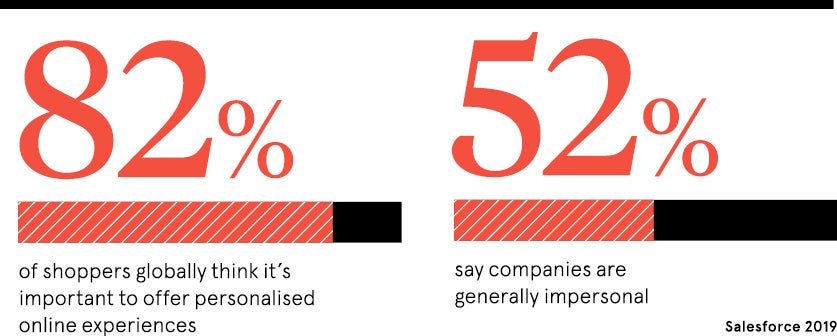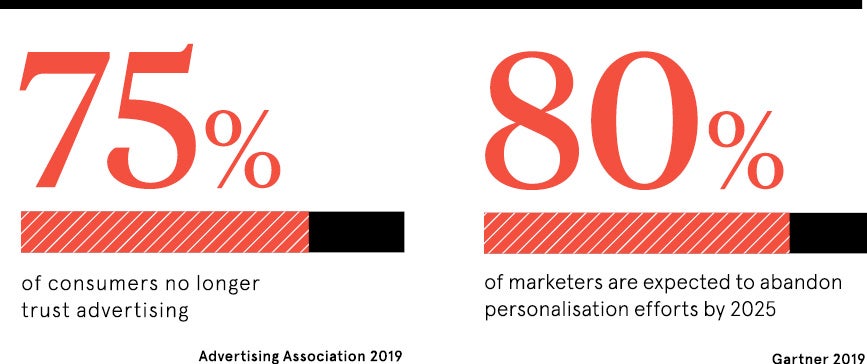NO: Hyper-personalisation is not killing creativity
This doom-mongering is nothing new for Charles Vallance, founding partner and chairman of challenger agency VCCP. “Since I started in advertising, in 1987, the industry has been dogged by dire predictions of decline,” he says.
Vallance points out the latest Advertising Association/Warc figures, published in January, reveal the UK enjoyed its 25th consecutive quarter of growing advertising spending. “Not bad for an industry on the skids,” he remarks.
Shadi-Sade Sarreshtehdarzadeh, Ogilvy UK’s strategy director, offers another tongue-in-cheek response: “Television is dead. Print is dead. Hyper-personalisation spreading like a virus that kills creativity. Every new format or innovation that comes along seems to be the first sign of the apocalypse.”
While Sarreshtehdarzadeh acknowledges that hyper-personalisation is “invasive”, it has “incredible potential to bring a brand’s story to life”. Advertisers must think like Dadaist Marcel Duchamp, whose upturned urinal pushed the boundaries of creativity in 1917. “Right now, hyper-personalisation is just an unwashed urinal. But, whether we like it or not, it is useful,” she says.

Hyper-personalisation can drive creativity
Similarly, Patrick Clover, chief executive of Scottish startup Stampede, believes hyper-personalisation will spur creativity. “In the early days of advertising, a business would have one brand, one message, one strapline, and repeat the same thing across TV, radio and print,” he says.
“In 2020, businesses still need that big international umbrella brand, but they also need hundreds of creative ideas targeting individual regions, media, users and scenarios. Great personalisation requires great ideas, but at an unprecedented scale.”
M&C Saatchi’s senior art director Tom Kennedy is treading carefully. “What makes hyper-personalisation different from the other shiny new toys for clients, creatives and strategists is the scale of the risk it carries,” he says. “In January, Aviva addressed its whole email base as ‘Michael’, proving that with even the most basic data, mistakes can happen. The assumptions, errors and insults will be amplified with each step more personal.”
He is, however, “cautiously optimistic we’re about to make some incredible work”. Kennedy continues: “The focus is on making sure the customer feels respected, ensuring there’s a genuine reason and human insight behind the data we’re using, delivered with the craft and value it deserves.”
Salesforce UK head of retail Michael Green believes advertisers should give people what they desire: “Consumers increasingly want on-demand, personalised experiences that utilise digital channels to make products and services more accessible.” He references the Salesforce 2019 State of the Connected Customer report that indicates 82 per cent of shoppers globally think it’s important to offer personalised online experiences.
First, you must understand your customer
Further, a SAS-sponsored report, Experience 2030: The Future of Customer Experience, suggests that 81 per cent of customers expect to engage with chatbots in a decade. Tiffany Carpenter, head of customer intelligence at SAS UK and Ireland, says: “Brands looking to stay ahead of the curve by offering personalised services have huge scope for creativity as long as their insights are underpinned by cutting-edge data analytics deployed to understand their customers at a granular level.
“Artificial intelligence (AI) will be essential for brands to analyse huge volumes of customer data in the time necessary to deliver the next best action at the right time, via the right channel.”
For Mike Klinkhammer, director of advertising sales for eBay in Europe, the debate around personalisation versus creativity completely overlooks one of the most important factors in any advertising experience: context. He says: “Advertising can be perfectly personalised and outrageously creative, but if you miss the mark when it comes to context, consumers might consider the ad annoying, potentially damaging the brand’s reputation.”
Netflix, Spotify and Amazon lead the way in hyper-personalisation, thanks to their treasure troves of data, says Peter Booker, business director at Brave. “Hyper-personalisation is not the death of creativity in advertising, but rather another avenue for it in the ever-expanding communications mix,” he says. “Indeed, creativity is the key to the longevity of hyper-personalisation.”
Personalisation could potentially limit the opportunity for random discovery or the joy of serendipity
YES: Hyper-personalisation is a rising danger for brands
A Gartner report in December predicted that 80 per cent of marketers will abandon personalisation efforts by 2025, due to lack of return on investment, the perils of customer data management or both.
This chimes with Jason McNellis, senior director analyst at Gartner, who warns: “While 87 per cent of marketing organisations are pursuing some level of personalisation, it is starving creative advertising of resources. Brands risk getting mesmerised by the glow of their personalisation dashboards at the expense of building longer-term brand equity and awareness.”
Obsessing about personalisation will lead to cuts in advertising spend, and soon, says McNellis. “As chief marketing officer budgets have dropped to their lowest levels in the last five years, the pressure to defund creative and brand, which often suffer from less rigorous measurement, will likely increase.”
Will Lion, managing partner of strategy at BBH London, says: “Hyper-personalisation is probably already killing creativity,” thanks to the myopic attitude of many within the industry. “The dual impacts of short-termism in marketing and lower investment behind creativity, of which hyper-personalisation is surely one of the poster boys, halved the success of creativity over just four years, according to a study by Binet and Field in 2018,” he says.
Risk of seeming too invasive
Also worried is Adam Powers, chief experience officer at Tribal Worldwide London. He says: “Too many brands have been caught focusing on purely the personalisation of communications and marketing, which has led to the consumer perceptions of snooping, breached privacy and being stalked around the web with customised banner ads.
“There is a risk that this next generation of personalisation could further shrink the bubbles of people’s sphere of interest. Potentially that will limit the opportunity for random discovery or the joy of serendipity.”
The Advertising Association’s Arresting the Decline of Public Trust in UK Advertising, launched last May, found that 75 per cent of consumers no longer trust advertising. This is in part because advertisers have been distracted by personalisation, says Malcolm Devoy, chief strategy officer at PHD, Europe, Middle East and Africa. “Great advertising is not the art of persuasion; it is the art of entertainment. As marketers seek hyper-personalisation, they switch focus from being entertainers to being persuaders. And given that consumer trust is at an all-time low, being ‘persuasive’ is not typically a job advertising performs well.”

The danger of giving an algorithm control
Some 58 per cent of UK consumers are willing to share data with brands in return for benefits, an increase of 11 per cent since 2016, according to latest research published in late-February by the Data and Marketing Association (DMA). Despite the appetite for hyper-personalisation, it doesn’t necessarily mean it is suitable for brands and advertisers, argues Tim Bond, DMA head of insight. Poor quality or misused data should be a big concern.
“When things go right, they will go wonderfully right, and when things go wrong, they could hinder the customer experience,” he says. “If an algorithm incorrectly profiles us, we could lose access to more than just offers, products or services, but even our rights.”
Parry Malm, chief executive and co-founder of Phrasee, a startup using AI to generate marketing copy, is unsure whether hyper-personalisation is what consumers want. “Creative advertising has the unique ability to be a cultural zeitgeist,” he says. “It’s why people know more about meerkats than ever before or why supermarket ads at Christmas make headlines. Good, branded advertising is a tribal experience.
“The problem with personalisation is that it’s not a shared experience, so you give up any ability to make your brand stand out. If you care about more than short-term metrics, then you need to focus on nailing your message, not just for today, but for tomorrow and beyond. A perfectly personalised message means nothing if you’re out of business.”
NO: Hyper-personalisation is not killing creativity

